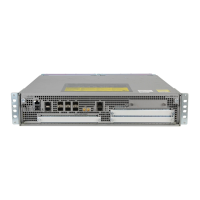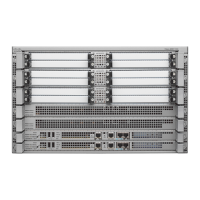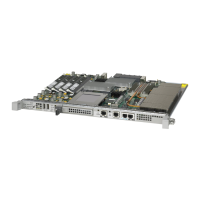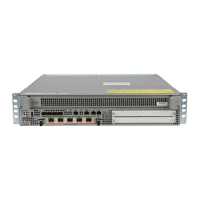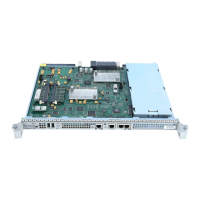27-17
Cisco ASR 1000 Series Aggregation Services Routers SIP and SPA Software Configuration Guide
OL-14127-08
Chapter 27 Classifying and Scheduling Packets for ASR 1000 Series
Information About Ingress Scheduling
• Inter-CC Scheduling, page 27-17
• Behavioral Changes in Scheduling, page 27-17
• Configuring Intra-CC Scheduling, page 27-18
• Configuring Inter-CC Scheduling, page 27-20
Scheduling Overview
The ASR 1000 Series Routers support ingress oversubscription. After the ingress packets are classified
as high priority and low priority, the packets are scheduled according to the priority. The ingress
classification and scheduling features have to work in conjunction to handle oversubscription.
Bandwidth oversubscription occurs at two levels, the SIP level (intra carrier card scheduling) and at ESP
(inter carrier card scheduling) level. The decision to configure scheduling at the SIP level is based on the
number of SPAs within a SIP and the scheduling decision to configure the scheduling at either SIP or
ESP level is based on the number of SIPs in a router. The following section describes intra-CC
scheduling and inter-CC scheduling.
Intra-CC Scheduling
Under intra-CC scheduling, the high-priority packets that are already classified by the SIP or the SPA
are scheduled and processed first. By default, all high-priority packets are processed first, and then the
excess bandwidth is shared among the low-priority packets, based on either the weight assigned to the
interface or the entire SPA. Configuring weights provides an option in distributing the excess bandwidth
among different interfaces to schedule low priority packets. Intra-CC scheduling is supported in all
SPAs, SIP-10, and SIP-40.
To assign excess weight to a clear-channel SPA (POS, ATM, Ethernet, or Serial SPAs), execute the plim
qos input [weight weight] command from Main interface configuration mode. This command was
earlier supported on only Ethernet SPAs. From Cisco IOS XE Release 3.1S onwards, the command is
supported on all clear-channel SPA on Cisco ASR 1000 Series Router.
To assign excess weight to low-priority packets on channelized SPAs, execute the hw-module subslot
{slot/subslot} qos [weight weight] command in Global configuration mode.
Inter-CC Scheduling
Oversubscription occurs at both the SIP level and the ESP level. Inter-CC scheduling has been
introduced to handle the oversubscription at the ESP level. In this scenario, the traffic sent from all the
SIPs to the ESP. It is not mandatory to configure scheduling at the ESP level. It depends on the number
of SIPs connected to the ESP. Inter-CC scheduling is needed whenever an oversubcription situation is
encountered or there is a need to prioritize certain traffic or there is a need to give different bandwidth
allocation to different types of traffic. To configure the minimum bandwidth service for the SIP and
distribute the excess weight to the low priority packets on the per ESI link per CC, execute the
hw-module slot slot-number qos input link link-index {bandwidth value | weight weight} command
from the Global configuration mode.
Behavioral Changes in Scheduling
In Cisco IOS XE Release 6.0 and earlier images, by default, the SIP-10 scheduler and the ESP scheduler
ran in port-fairness and ESP-fairness mode where each buffer is scheduled at a rate proportional to its
interface bandwidth. As a result, even high-priority packets were treated based on a rate that was

